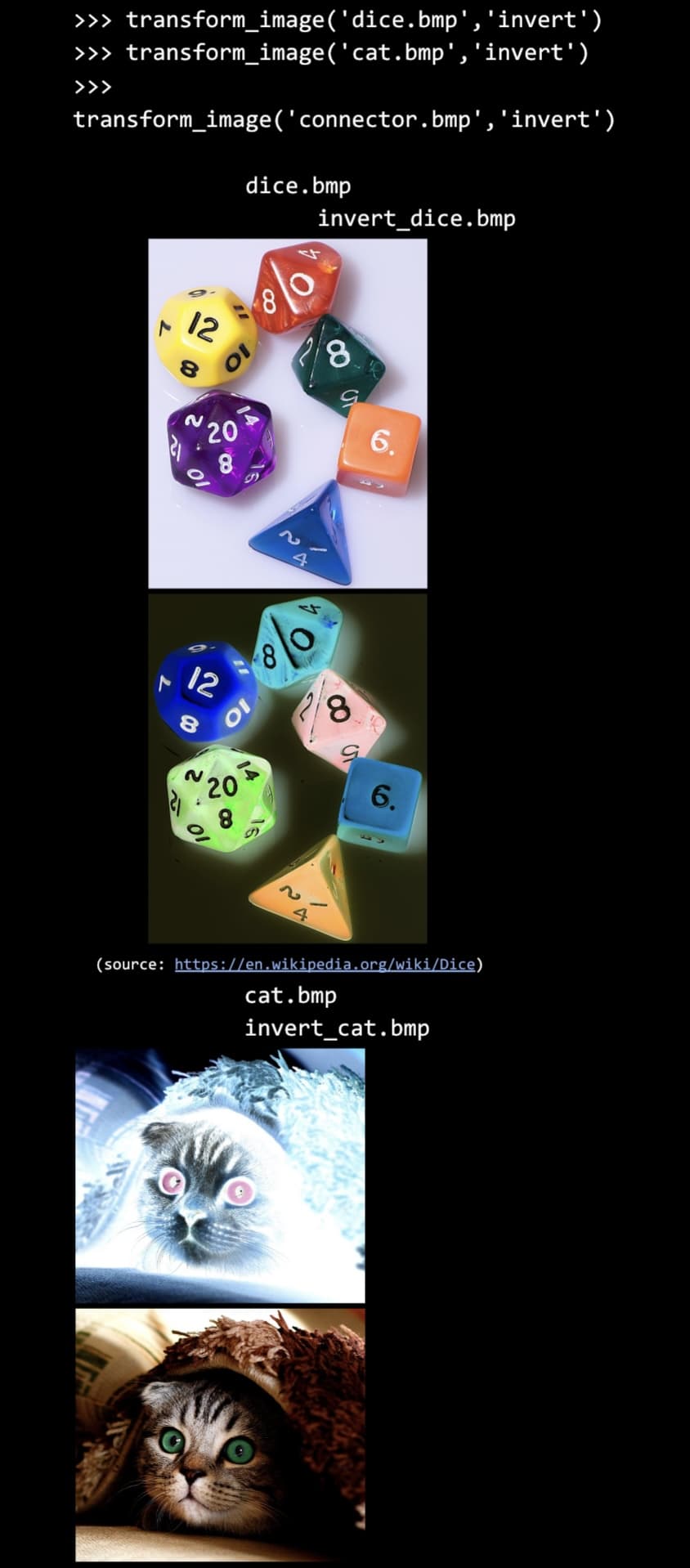First, you will be implementing the invert function. (Reminder: all of these functions take in a three-dimensional list, and return a three-dimensional list: it's up to you whether to create a new list or alter the original). This function performs a color inversion, as though you were producing a negative of a photo. Recall that each color component in every pixel is an integer between 0 and 255, inclusive. In every pixel, for each of the three color components, if the original value for the component was x, to invert the color you must set it to 255-X.
First, you will be implementing the invert function. (Reminder: all of these functions take in a three-dimensional list, and return a three-dimensional list: it's up to you whether to create a new list or alter the original). This function performs a color inversion, as though you were producing a negative of a photo. Recall that each color component in every pixel is an integer between 0 and 255, inclusive. In every pixel, for each of the three color components, if the original value for the component was x, to invert the color you must set it to 255-X.
Computer Networking: A Top-Down Approach (7th Edition)
7th Edition
ISBN:9780133594140
Author:James Kurose, Keith Ross
Publisher:James Kurose, Keith Ross
Chapter1: Computer Networks And The Internet
Section: Chapter Questions
Problem R1RQ: What is the difference between a host and an end system? List several different types of end...
Related questions
Question
In python
![First, you will be implementing the invert function.
(Reminder: all of these functions take in a
three-dimensional list, and return a three-dimensional list:
it's up to you whether to create a new list or alter the
original). This function performs a color inversion, as
though you were producing a negative of a photo. Recall
that each color component in every pixel is an integer
between 0 and 255, inclusive. In every pixel, for each of
the three color components, if the original value for the
component was x, to invert the color you must set it to
255-X.
Hint:
Go look at the swap_red_blue example near the
bottom of your hw06.py template if you're uns
unsure
how to loop through the pixels and access specific
colors at each pixel.
Examples:
>>> invert([[[127, 127, 127], [0, 0, 0]],
[[255, 255, 0], [50, 128, 255]],
[[0, 0, 255], [0, 255, 0]],
[[255, 0, 0], [255, 255, 255]]])
[[[128, 128, 128], [255, 255, 255]],
[[0, 0, 255], [205, 127, 0]],
[[255, 255, 0], [255, 0, 255]],
[0, 255, 255], [0, 0, 0]]]
>>> invert([[[36, 155, 90], [63, 208,
208], [151, 3, 14]],
[[53, 204, 53], [99, 103, 10], [94, 138,
216]]])
[[[219, 100, 165], [192, 47, 47], [104,
252, 241]],
[[202, 51, 202], [156, 152, 245], [161,
117, 39]]]
(note that the highlighting and the new line for each row
are for clarity purposes only and will not be present in the
actual console output, but the numbers should be correct)](/v2/_next/image?url=https%3A%2F%2Fcontent.bartleby.com%2Fqna-images%2Fquestion%2Fea258185-b79a-47d1-99df-8ec857b3195a%2F6a232642-4b41-41c6-ab4c-0b025e841f09%2Faallhzm_processed.jpeg&w=3840&q=75)
Transcribed Image Text:First, you will be implementing the invert function.
(Reminder: all of these functions take in a
three-dimensional list, and return a three-dimensional list:
it's up to you whether to create a new list or alter the
original). This function performs a color inversion, as
though you were producing a negative of a photo. Recall
that each color component in every pixel is an integer
between 0 and 255, inclusive. In every pixel, for each of
the three color components, if the original value for the
component was x, to invert the color you must set it to
255-X.
Hint:
Go look at the swap_red_blue example near the
bottom of your hw06.py template if you're uns
unsure
how to loop through the pixels and access specific
colors at each pixel.
Examples:
>>> invert([[[127, 127, 127], [0, 0, 0]],
[[255, 255, 0], [50, 128, 255]],
[[0, 0, 255], [0, 255, 0]],
[[255, 0, 0], [255, 255, 255]]])
[[[128, 128, 128], [255, 255, 255]],
[[0, 0, 255], [205, 127, 0]],
[[255, 255, 0], [255, 0, 255]],
[0, 255, 255], [0, 0, 0]]]
>>> invert([[[36, 155, 90], [63, 208,
208], [151, 3, 14]],
[[53, 204, 53], [99, 103, 10], [94, 138,
216]]])
[[[219, 100, 165], [192, 47, 47], [104,
252, 241]],
[[202, 51, 202], [156, 152, 245], [161,
117, 39]]]
(note that the highlighting and the new line for each row
are for clarity purposes only and will not be present in the
actual console output, but the numbers should be correct)

Transcribed Image Text:>>> transform_image('dice.bmp', 'invert')
transform_image('cat.bmp', 'invert')
>>>
>>>
transform_image('connector.bmp','invert')
12
8
20
8
12
dice.bmp
ol
20
invert_dice.bmp
8
8
6.
6.
(source: https://en.wikipedia.org/wiki/Dice)
cat.bmp
invert_cat.bmp
Expert Solution
This question has been solved!
Explore an expertly crafted, step-by-step solution for a thorough understanding of key concepts.
This is a popular solution!
Trending now
This is a popular solution!
Step by step
Solved in 3 steps with 1 images

Recommended textbooks for you

Computer Networking: A Top-Down Approach (7th Edi…
Computer Engineering
ISBN:
9780133594140
Author:
James Kurose, Keith Ross
Publisher:
PEARSON

Computer Organization and Design MIPS Edition, Fi…
Computer Engineering
ISBN:
9780124077263
Author:
David A. Patterson, John L. Hennessy
Publisher:
Elsevier Science

Network+ Guide to Networks (MindTap Course List)
Computer Engineering
ISBN:
9781337569330
Author:
Jill West, Tamara Dean, Jean Andrews
Publisher:
Cengage Learning

Computer Networking: A Top-Down Approach (7th Edi…
Computer Engineering
ISBN:
9780133594140
Author:
James Kurose, Keith Ross
Publisher:
PEARSON

Computer Organization and Design MIPS Edition, Fi…
Computer Engineering
ISBN:
9780124077263
Author:
David A. Patterson, John L. Hennessy
Publisher:
Elsevier Science

Network+ Guide to Networks (MindTap Course List)
Computer Engineering
ISBN:
9781337569330
Author:
Jill West, Tamara Dean, Jean Andrews
Publisher:
Cengage Learning

Concepts of Database Management
Computer Engineering
ISBN:
9781337093422
Author:
Joy L. Starks, Philip J. Pratt, Mary Z. Last
Publisher:
Cengage Learning

Prelude to Programming
Computer Engineering
ISBN:
9780133750423
Author:
VENIT, Stewart
Publisher:
Pearson Education

Sc Business Data Communications and Networking, T…
Computer Engineering
ISBN:
9781119368830
Author:
FITZGERALD
Publisher:
WILEY